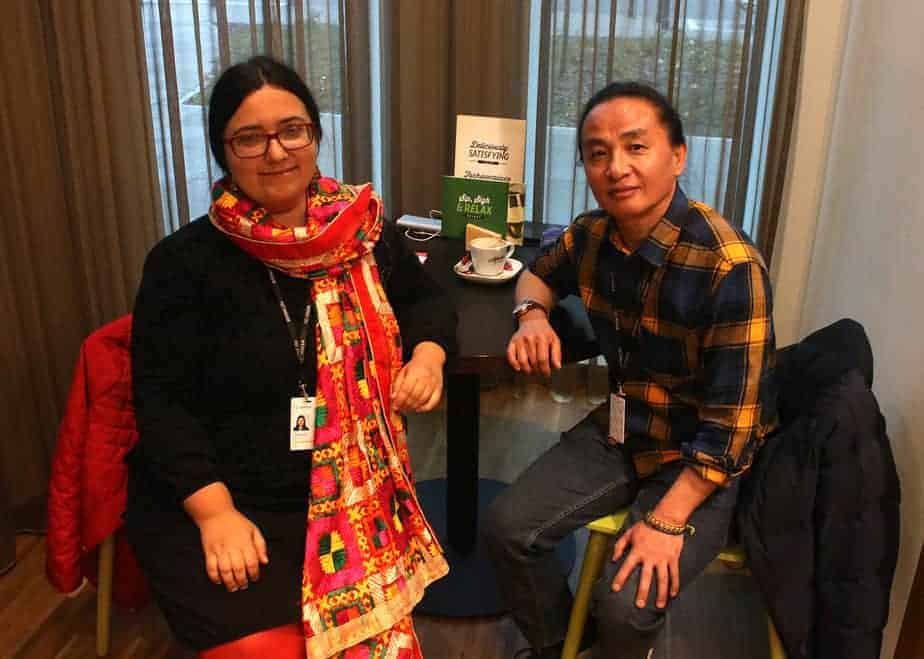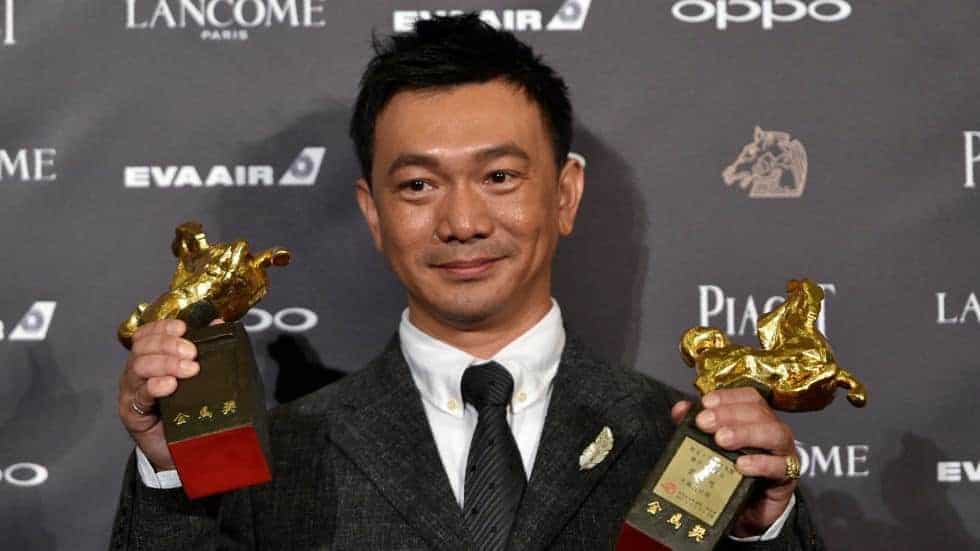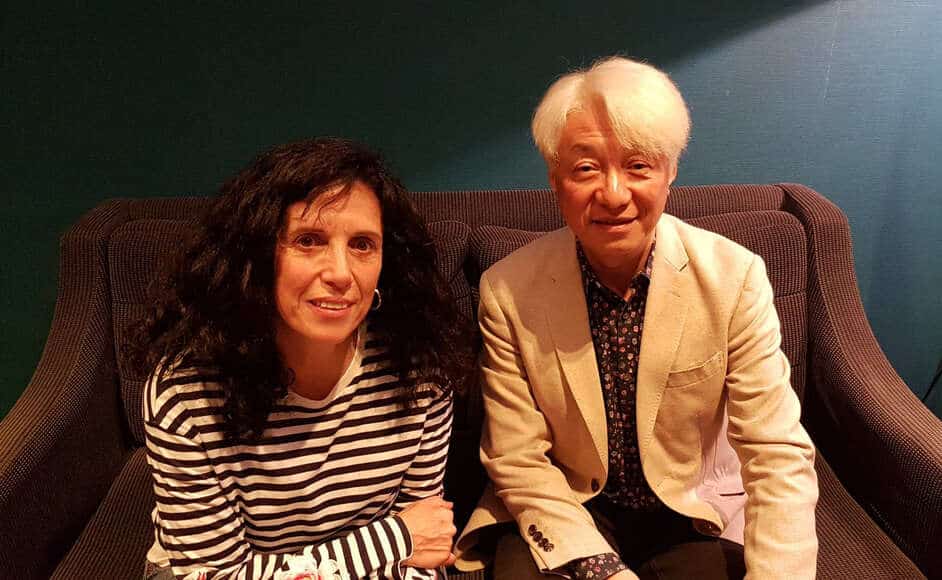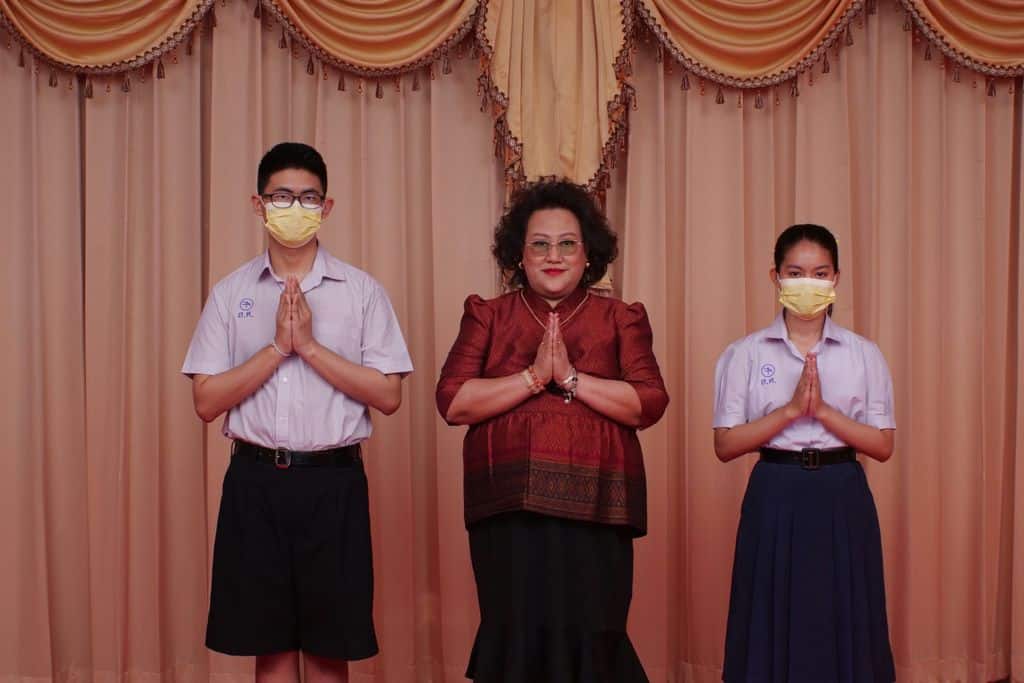Tashi Gyeltshen is a self-taught filmmaker from Bhutan. One of his shorts, “The Red Door” (2014), premiered at Rotterdam. “The Red Phallus“, with the script awarded with the Open Doors grant at Locarno festival in 2016, is the director's debut feature. On the occasion of the movie's screening during the Five Flavours Asian Film Festival, we talk with him, among some other topics, about Bhutanese tradtions, mask we all wear, creativity and the atrocities people are capable of.

You mentioned that the movie “Travelers and Magicians” was one of the reasons you became a filmmaker. Could you tell us something more about that? How did it happen? Because I know you worked as a journalist…
Actually, initially I wanted to become a poet. Unfortunately, my writings weren't good enough. I was working as a journalist, but I had some problems with my editor and got fired. So there I was, jobless, just roaming around, looking for an inspiration what else I can do in life. I happened to watch “Travelers and Magicians” and it struck me that I could become a filmmaker. Because of that film, somehow I felt a bond with my cultural roots, and as a result I could discover my own stories, as well as I could connect to the stories of my own country. Cinema industry in Bhutan is relatively new, with mainstream movies similar to Bollywood films, which we watched growing up. We also were exposed to mainstream Hollywood movies and for a big part of my life, I wasn't aware that independent cinema, which is the cinema I perceive as an art form, exists. Because of that, I wasn't connected to my own culture, wasn't connected to my own stories through cinema as the medium of storytelling. So when I watched “Travelers and Magicians” I realized those limitless possibilities in which indigenous stories can be told. Not that I liked this movie so much. Of course, it's a great film, but its importance for me comes from the fact it connects me to something much deeper.
From what you say, I guess filmmaking helps you to connect to your roots?
Yes, it connects me with my cultural heritage, the stories immersed in my reality. And since I'm born and brought up in Bhutan and I live in Bhutan, so I think my connection with local stories is stronger than with tales from some other places.
I remember from the talks with Bhutanese filmmakers, who visited the festival a couple of years back, when it hosted a huge retrospective of Bhutanese cinema, that there are no film schools in Bhutan. How did you learn the craft?
Well, I'm a self-taught filmmaker. And it was a very difficult process, because when you are learning on your own, you don't have any guidance and don't know what direction you should seek. There is no mentor you can rely on, who can dispel your doubts. You read and study whatever materials you can get and reach for any available tools. And that's how I learned, which was a difficult and time-consuming process for me, a matter of many trials and errors… But I dealt with it, being so passionate about cinema.
“The Travelers and Magicians” was one of the first movies from Bhutan, which reached an international audience. Since then, some more like “Hema Hema” or “Honeygiver Among the Dogs” were screened at festivals all around the world. Does it boost the cinema industry in Bhutan and have any impact on local filmmakers?
If we talk about independent cinema, over the past, let's say, 10–15 years there weren't many movies, and there are not many new independent filmmakers. Annually, maybe one film comes out of Bhutan with the potential to reach an international stage. I don't feel there is a big impact in terms of inspiring the new generation or making the cinemagoers realize that film is an important art form, which can be used for self-expression.
Is it possible to get governmental funding or are there any organizations supporting independent movies' production?
Unfortunately, there's no government funding or the organizations that support filmmakers, especially when it comes to independent cinema. You have to look for investors outside to finance the movie.

International audience seems to be very interested in Bhutanese cinema. Two years back, the Bhutanese retrospective was very popular, and as far as I remember, most of the screenings were sold out. The same case with your movie this year. What films does the Bhutanese audience choose, are they interested in these local movies praised at international festivals?
The interest is still very low. “Hema Hema” was banned in Bhutan. There were also censorship issues with my movie. They required a lot of cuts from me, which I had to accept, otherwise it would be banned as well. But with those cuts, there was no point in screening it. The film was ruined beyond repair.
What was the reason behind the cuts?
Some cultural issues, no specific reason. They cited “cultural sensitivity” and I didn't really want to push it further and ask, because screening the film in Bhutan financially does not make sense. Even if I managed to show it, I don't think it would survive for three days.
Yesterday, introducing your movie, you mentioned that you were surprised by the audience being so silent. How it is in Bhutan then?
I don't watch many films in Bhutan, because I'm not so interested in the mainstream film industry there. But when I watch, I find it quite irritating, when people talk during the screening or use their phones, and their mobiles start ringing, people come in and go out, it never ends. What I experienced here was total pin-drop silence. I was afraid to put my jacket on my lap because I thought the sound might disturb others. [laughter]

Let's go back to your movie. The main character's father carries the function of Atsara. Who are Atsaras in Bhutanese tradition?
It's a religious Buddhist icon. We will encounter those characters during the annual festivals called Tshechu, which are held in every district. At the festivals, monks perform Buddhist masked dances. The Atsaras, also wearing masks, are clowns. They usually carry wooden phalluses and they would make jokes, vulgar jokes, in front of the crowd. It doesn't matter if their audience consists of males or females, children or adults. That tradition originates from the Buddhist saint called Drukpa Kunley, who challenged the arrogance of the clergy, and their orthodox way of teaching Buddhism. He was known as the “Divine Madman” and his Buddhist teachings were very unconventional. He used symbolic phalluses, whose purpose comes from very distant times and shamanic traditions, to ward off evil spirits and to intimidate people. The purpose of the latter was to help humans to subdue their ego through shame, irrespective of their status. So Atsaras during the festivals bless the people with phalluses. All their pranks have the intention mentioned before. Through shame, which people experience in public, they are freed of their egos. Therefore, this way Atsaras help humans to reach enlightenment.
Could you tell us something more about the phallic cult in Bhutan? Is it still widely practiced?
You don't come across it in cities, but in villages, the tradition is still prevailing. We paint phalluses on the walls of houses, on the entrance, on both sides of the door. They come in many designs and patterns, you can even spot winged ones. We also hang wooden phalluses on the four sides of the houses. We protect a newly-built house with them, it is supposed to ward off the evil spirits and keep the malicious gossips away. It's also a symbol of fertility. Also, there's a monastery in western Bhutan called Chimi Lhakhang, which was founded by Drukpa Kunley, of whom we talked about. This monastery is dedicated to women, who can't conceive. If they have fertility problems, they go there for blessing, which is supposed to enable them to get pregnant. The area became a very touristy place nowadays, where they try to sell anything related to phalluses, like key rings and so on, to make money out of it.
Coming back to the Atsara figure, these clowns seem to mix what is sacred with what is profane. So there is a duality in their nature. And the duality of human nature is for me one of the central concepts of your movie.
Yes, the duality of human nature is the original philosophy behind the film. The concept came to me first, and then I contrived the narrative form, through which I wanted to tell about it. In Buddhism, we believe that each and every human being is born with a special seed, the potential to achieve enlightenment. The enlightenment in my understanding is the perfect idea of goodness. So we carry that seed, and a perfect human being may spring out of it. But although everyone can attain enlightenment, the reality of the world is dreary. We are destroying humanity, whether through wars or environmental disasters. How it is possible that we rape each other and kill each other, and destroy the Earth, which we call our home? Where does this cruelty come from? I am horrified by what people are capable of. Sometimes I don't even trust myself, what if I am also able to commit those dreadful deeds? So this is the question I pose to myself, “How can human beings be so atrocious?” Not that I have an answer or give it through my film. I am only asking.

You mentioned human beings are capable of attaining enlightenment. Your main character's name is Sangay, which means “An Enlightened One”. Was there a reason behind that?
You're the first one to ask me this question so far. From my side, it's some sort of irony. The name “An Enlightened One” contrasts with the way she is portrayed, how she is fighting, trapped within the old morality. She is fighting to be a better person, while oppressed by the society creating the suffocating, enslaving space.
So again, the duality we talked about. It is also present for me in a way people from Sangay's surroundings perceive the phallic cult. It is supposed to be accepted by the culture, but Sangay is bullied at school because of her father's profession. When she brings wooden phalluses to her aunt's home, a peer teases her. So on one side, it is a tradition bearing deeper meanings, but on the other, the people from the village treat these wooden phalluses literally, as depictions of the male organ. Did you want to point hypocrisy connected with religious practices?
Partly yes. When you look at the certain shots in the film, you see Sangay's house, space where she stands, and a monastery. I placed the monastery in the background, the house in the middle, and Sangay is on the edge of the frame. It represents the conflict between religion, the values of the house where she was born, and her own identity. As soon as you are born into a universe, you're born into a house, which models you, crafts you into a human being, makes you whoever you are. You know each and every corner of that house, every bit of its space. The house shapes your idea of space, and it becomes your sanctuary. When something bad happens inside, you hide it to protect the sanctity of your home. And all that is morally weighted down by religion. Of course, religion has good sides, but there is a lot of hypocrisy in how it judges what is right and what is wrong. Looking from the individual's perspective, culture and religion can be suffocating.
And from what you say, your concept of the house seems to be another mask in the movie…
Yes. When you look at a house from the outside, you see either a palace or a hut. You assume that all the people inside the palace, or a lavish mansion, must be living a splendid and prosperous life. And while you look at the hut, you pity its inhabitants, presuming they have nothing. Sometimes I think that the idea of empathy, of getting into somebody else's truth and trying to understand it, is dying away because those speculations go down to a façade, where everything is measured by material wealth. Yet who knows? The people living in the hut can live a perfect and harmonious life.

We can speak of a façade, or a mask, also in the case of Sangay. She seems very subdued, although there are so many emotions bustling inside her…
This is the situation in a patriarchal society. The female character from my movie is subdued by culture. She was taught not to speak up, she is not allowed to express herself freely. I grew up in a society in which we're not supposed to speak up. We're not supposed to challenge the status quo. We're not supposed to argue with elders, we must respect them. Of course, I'm not saying that we shouldn't respect the elders. I am saying that respect doesn't mean staying silent, when something bad happens or that you shouldn't question the old order, especially that culture is sometimes used to subdue one's personality and identity.
Speaking of patriarchal society, all the males surrounding Sangay are toxic and oppressing. Even the man she is meeting with, on the one hand, he is trying to encourage her to make her own decision but on the other, is a predator.
Even when he tells her to make her own decision, he is doing it only to his advantage. We, human beings, never mean what we say. We never tell the whole truth. Every conversation, every relationship, is based on a certain kind of deceit because we all wear masks, which we have nurtured. I'm never 100% me. When I meet people, I act according to the situation, according to conditions, according to whom that particular person is, and according to that particular space and time. We adapt because we want to be loved or want to be hated, and from the fear of loneliness. Yet not everyone does things to be loved, we sometimes intentionally act in a way, which won't be praised.
Is Sangay like that?
Sangay does a lot of things in certain ways and she repeatedly gets hurt. It cumulates intense emotions, this cycle of reacting and being hit. The emotions, which need to be released. The idea of revenge arises from that particular thought, the circle, in which a victim turns into someone powerful, unleashing fear and anger.
I was wondering if Sangay surrounded by toxic masculinity was a vision you needed for this particular story or does it reflect your general idea of what modern women still experience, despite the fact that we live in the 21st century?
When people watch a film, then they tend to think: “The film is very dark and it depicts toxic masculinity” or “Oh, I never knew that Bhutan is like that”. But it's a story about one particular person, the story about Sangay, not reflecting the whole complexity of the country and society. But again, the story of Sangay in a way symbolizes the story of women in general. So it goes both ways. Rapes happen anywhere in the world, also in Bhutan. I associate rape with rules of the patriarchal society, with the idea of power. And violence is connected with power. The patriarchal society cements structural violence.

Could you tell us something more about your use of colors?
I wanted to keep colors subdued; however, using bewitching frames to mirror how violence lurks underneath the mesmerizing beauty. If you glanced at the Earth from a distance of Cosmos, you'd see this stunning blue sphere and you could never imagine there are so many atrocities happening there at this particular moment. You wouldn't know how many people are getting raped or killed or hurt in some other way. So I wanted the film to look as beautiful as possible. However, this perception, when people associate beauty with goodness, is very shallow. It is just another façade or mask.
It reminds me of the belief that Bhutanese are the happiest nation… But you portray a society that is not free from violence. It was very ironic that one of the characters says “I doubt anyone can get out of this paradise”. The paradise for him is a prison.
I don't think there is such thing as paradise. In Buddhism, we perceive life as something you need to get out of, and to do so you have to attain enlightenment. To attain enlightenment, you must be detached from human emotions, which are part of life. Sometimes I think that life is the art of endurance. Success comes when you bear the suffering, and then maybe you can reach a point at which you think you are accomplished or people assume that you are such. So paradise is an utopian idea. Every country has its own problems and so has every human being. There's no happiness without its opposite, so to give the concept of happiness more dimensions, you need diverse stories. So the story of how you suffered or what tough times you've gone through should be also included, to paint the bigger picture. Thus, by telling diverse stories, we point that life is complicated and it takes a lot of hard work and passion, and loads of endurance, to be happy.
Why the diversity of stories is so important?
The environment survives on the essence of being diverse. If there are no bees, I believe that human life will end in another 50 years. We are all interconnected, we are interdependent, and human beings are just a very small part of the system. So it is also important for you here to watch Bhutanese films, my film, to understand human nature better, to see the world through a different lens, to learn more about another culture.
There's one scene I would like to ask you about. The very beautiful and poetic sequence of Sangay waving that long white fabric. What was your intention behind it?
The scene is very surreal, as it happens in a valley, with a textile being so long. I used yarn as a symbol of life. And the textile is a metaphor for creativity. We call these traditional woven fabrics kishutharas. They are considered as the prized possession of Bhutanese woman, and, for example, are worn on special occasions like festivals. Their patterns and designs are very complex, sometimes it takes several months to complete one piece. So kishutharas have a special place in our culture. In my movie, it is a symbol of creativity… and a symbol of the movie itself.
Is this act of weaving something which helps Sangay to connect with her emotions?
Well, it was more about me as a filmmaker being self-indulgent [laughter]. I wanted to show that no matter what you're going through, the idea of beauty must be kept alive. And it's so important. Civilization has always moved forward because of creativity and innovation.
So is creativity a ray of hope for humanity? Because there's not much hope in your movie.
Exactly. The idea of being creative is to hope. It doesn't matter whether the story is dark or heartwarming. Art should embrace life in many of its aspects and shades, with all disappointments and moments of despair. I think the idea of creating is hope itself because if you don't hope, you wouldn't be able to create.
So let's wrap up on this optimistic note.















